
Edition 2013
Edition 2012
Edition 2010, 2009, 2008 |
|
 |
SUBSTITUT - DIE PUBLIKATION
(scroll down for english)
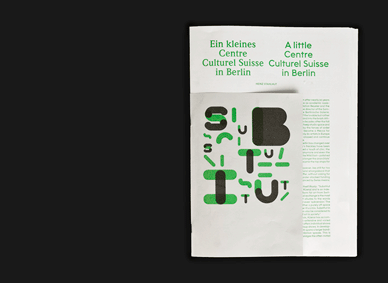
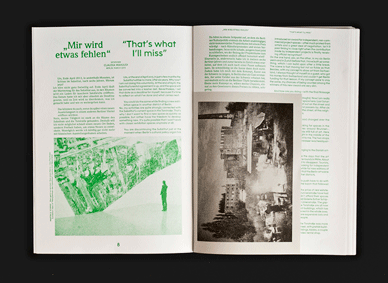
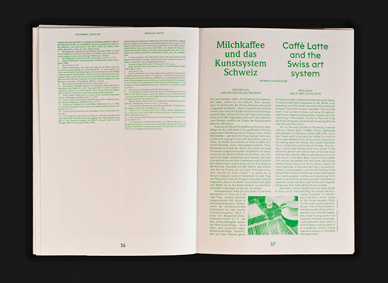
Die Publikation wurde während der Ausstellung "Es liegt was in der Luft" vom 20. bis 23. März im Substitut entworfen und mit einem Risographen gedruckt. Jedes Exemplar wurde vom onlab-Team und Substitut von Hand hergestellt.
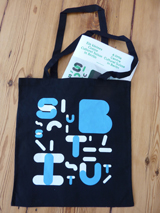 |
Erhältlich im Substitut
vom 10. bis 19. April
oder über Postversand
(Bestellungen an: info@substitut-berlin.ch)
Wenn Sie ein Exemplar reservieren und im Substitut abholen möchten, schreiben Sie bitte eine entsprechende Mail.
25 Euro plus 3 Euro Versandkosten
30 CHF plus 5 CHF Versandkosten
zu den ersten 150 Ex. gibt es eine Baumwolltasche |
Limitierte, signierte und nummerierte Edition (25 Ex.) mit Baumwolltasche und
Spezial: Im Substitut liegen während Martin Schicks Ausstellung „Prospective (2013 – 2015)“ 125 5-Euroscheine zum Verkauf. Werden diese irgendwann erworben, erhalten alle, die eine limitierte Ausgabe dieses Buches gekauft haben, einen 5-Euroschein um in das Buch zu legen.
45 Euro (inkl. Versandkosten)
55 CHF (inkl. Versandkosten)
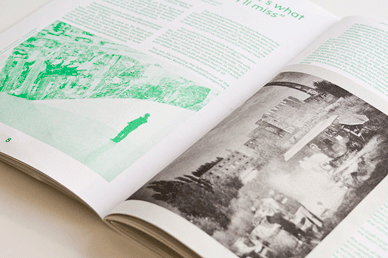
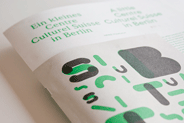 
Mit Beiträgen von den Künstler/innen (Bildbeispiele unten):
Marc Bauer, Patricia Bucher, Beide Messies, Les Frères Chapuisat, Ruth Erdt,
El Frauenfelder, Nicolas Galeazzi, Goran Galic / Gian-Reto Gredig, Emanuel Geisser, Melanie Gugelmann, Haus am Gern, Christina Hemauer/Roman Keller, Susanne Hofer, Georg Keller, knowbotiq, Aurelio Kopainig, Isabelle Krieg, !Mediengruppe Bitnik,
Cat Tuong Nguyen, Delphine Reist / Laurent Faulon, RELAX (chiarenza & hauser & co), Martin G. Schmid, Loredana Sperini, Vreni Spieser, Nina Stähli, Ana Strika,
Christoph Wachter/Mathias Jud, Christian Waldvogel, Andrea Winkler.
Mit Texten (Deutsch und Englisch) von:
(Auszüge unten)
Grusswort von Heinz Stahlhut
Claudia Wahjudi sprach mit Urs Küenzi über das Substitut und Berlin.
Emilia Sulek schildert ihre Sicht auf das Substitut als Aufsicht und Anthropologin.
Kordula Fritze-Srbic analysiert die Berliner Kunstlandschaft und die sich ändernden Voraussetzungen für die freie Szene.
Christian Saehrendt bezweifelt, dass Künstler/-in ein Traumberuf sei, hat aber ein Erfolgsrezept.
Heinrich Gartentor steckt in Mannheim fest, und denkt bei Milchkaffee über das Kunstsystem Schweiz und seine politische Karriere nach.
Sally De Kunst unterhielt sich per Skype mit der Künstlerin Maria Guggenbichler über die Rolle von Kurator/-innen und verfasste mit ihr ein Manifest.
Auszüge aus Texten:
Christian Saehrendt, "Traumberuf Künstler":
"(…) Künstler ist nicht gleich Künstler. Es gibt zwar immer mehr Künstler, doch die meisten von ihnen agieren auf einer wenig professionellen Ebene, sind Hobby-, Teilzeitkünstler oder allenfalls regional bekannt. An der Spitze ist nämlich nach wie vor nur begrenzt Platz. Doch wie wird man zu einem international beachteten, von den Qualitätsmedien und Museen geschätzten, und gut verdienenden professionellen Künstler? Der Kunstbetrieb funktioniert, bildlich ausgedrückt, wie ein Insiderkartell. Urteile über Künstler und Bewertungen von Werken resultieren häufig aus Gerüchten, informellen Absprachen, persönlichen Vorlieben und persönlichen Beziehungen. Die Macht im Kunstbetrieb scheint unsichtbar zu sein und wirkt deshalb faszinierend. (…)"
Sally De Kunst und Maria Guggenbichler, "Dialog mit Maria":
"(…) Sally De Kunst: Der entscheidende Aspekt beim Kuratieren ist für mich die Gastfreundschaft (Hospitality). Ein starkes künstlerisches Programm kann nur stattfinden in einer freundlichen, einladenden Atmosphäre, wenn ein breites Publikum, Künstler und andere Mitglieder der Gemeinschaft, sich willkommen fühlen. Ich verstehe eine solche Gastfreundschaft (Hospitality) als etwas sehr explizites. In diesem Sinne verweist das englische Wort „host“ (Gastgeber) auf den „Herrn des Hauses“, den „Master of Ceremonies“, den „Gastwirt“, den „Mentor“ oder den „Facilitator“. In den vergangenen Jahrzehnten wurde die Rolle des Kurators dann breitgefächerter verstanden, der Kurator ist jetzt auch ein „Produzent“, „Agent“, „DJ“, und zahlreichen anderen Funktionen. Es ist ein sehr vielschichtiger Beruf. Aber für mich ist der Kurator in erster Linie der Gastgeber (Host) für die Künstler, für das Publikum und alle anderen Beteiligten.
Maria Guggenbichler:
Das sehe ich genauso. Gespenster erschaffen: A guest + a host = a ghost (…)"
Heinrich Gartentor, "Milchkaffee und das Kunstsystem Schweiz":
"(…) Nun hätte ich die einmalige Gelegenheit, in die Politik einzusteigen und 2014 für die Legislative des Kantons Bern zu kandidieren und mich für die Kunst stark zu machen. Man räumt mir exzellente Wahlchancen ein, da man mein Gesicht in der breiten Öffentlichkeit kennt und ich mich stets in die Debatten einmische – nicht nur wenn es um Kunst geht, und man traut mir zu, Parteifronten abzubauen, weil ich so gut mit allen reden könne. Ich wurde kontaktiert von links bis Schweizerische Volkspartei. Ich scheine so massentauglich zu sein wie mein Milchkaffee. Ich würde politischer Nachfahre des Malers Albert Anker 6 werden, der von 1870–1873 in der Legislative des Kantons Bern saß und sich für die Belange der Kultur einsetzte, insbesondere für den Bau eines Kunstmuseums in Bern.
Nun will sich übrigens auch das Kunstmuseum Bern erweitern. Die Planung läuft, die Finanzierung ist unklar, von den hohen Betriebskosten spricht niemand. Ich würde als Politiker nicht in Ankers Fußstapfen treten können; er würde heute wohl auch nicht in die seinen treten wollen. (…)"
Bilder:
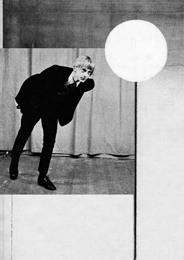 |
|
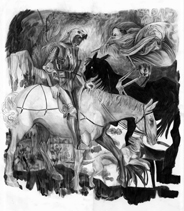 |
|
|
|
| Emanuel Geisser, a moon or a button, 2013. |
|
Marc Bauer, Death Rider, 2011. |
| |
|
|
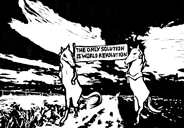 |
|
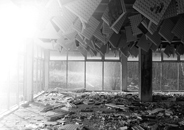 |
|
|
|
| Patricia Bucher, The Only Solution Is World Revolution', 2012. |
|
Susanne Hofer, Still aus der Serie "Aufhellung", 2012. |
|
 |
SUBSTITUT - THE PUBLICATION



The publication has been designed at and printed with a risographer at Substitut from March 20th till March 23rd 2013 in the frame of the exhibition "Es liegt was in der Luft".
Every copy is handmade by the onlab team and Substitut.
 |
available at Substitut
from April 10th - 19th
or by mail (order at info@substitut-berlin.ch)
if you want to reserve a copy and pick it up at Substitut, please write a mail.
25 Euro plus 3 Euro shipping costs
30 Swiss Francs plus 5 Swiss Francs shipping costs
first 150 ex come with a cotton bag |
limited, signed and numbered edition (25 ex) with cotton bag and a special:
During the exhibition „Prospective (2013 – 2015)“ by Martin Schick, there are 125 5-Euro bills on display for sale. When someone buys them someday, everyone who has bought a limited edition will receive one bill to put into the book.
45 Euro plus (shipping costs incl.)
55 Swiss Francs (shipping costs incl.)

 
with contributions by the artists:
Marc Bauer, Patricia Bucher, Beide Messies, Les Frères Chapuisat, Ruth Erdt,
El Frauenfelder, Nicolas Galeazzi, Goran Galic / Gian-Reto Gredig, Emanuel Geisser,
Melanie Gugelmann, Haus am Gern, Christina Hemauer/Roman Keller, Susanne Hofer,
Georg Keller, knowbotiq, Aurelio Kopainig, Isabelle Krieg, !Mediengruppe Bitnik,
Cat Tuong Nguyen, Delphine Reist / Laurent Faulon, RELAX (chiarenza & hauser & co),
Martin G. Schmid, Loredana Sperini, Vreni Spieser, Nina Stähli, Ana Strika,
Christoph Wachter/Mathias Jud, Christian Waldvogel, Andrea Winkler.
with texts by (English and German):
(excerpts below)
Greeting by Heinz Stahlhut
Claudia Wahjudi spoke intimately with Urs Küenzi about the Substitut and Berlin.
Emilia Sulek gives her view of the Substitut as both attendant and anthropologist.
Kordura Fritze-Srbic analyzes Berlin’s artistic landscape and the changes conditions in the independent scene.
Christian Saehrendt doubts that being an artist is a dream job but has a recipe for success.
Heinrich Gartentor is stuck in Mannheim and reflects over a caffè latte about Switzerland’s art system and his political career.
Sally De Kunst discusses via Skype with artist Maria Guggenbichler about the role of the curator and together they author a manifesto.
Excerpts:
Christian Saehrendt, "Dream job Artist”:
"(…) An artist is not automatically an artist. There are an ever-growing number of artists, but most of them only work in a semi-professional arena. They are artists by hobby, part time artists or remain local-level artists. At the top, however, there is as little room as ever. So, how does one attain the status of an internationally renown, appreciated by quality media sources and museums, and well-earning professional artist? The art business, to put it figuratively, works like a cartel of insiders: opinions of artists and evaluations of their works often are the result of rumor, informal agreements, personal tastes and personal relationships. The power structure in the art business seems to be invisible and is thus quite fascinating. (…)"
Sally De Kunst und Maria Guggenbichler, "Dialog mit Maria":
"(…) Sally De Kunst: The crucial aspect of curating for me is hospitality. A strong artistic program can only take place in a friendly atmosphere, where a large audience, artists and other members of the community feel welcome. I perceive such hospitality as very explicit. In this regard, the English word "host" refers to "the master of the house", "the manager", "the inn-keeper", "the mentor" or "the facilitator". In recent decades, the role of the curator has expanded also to "producer", "agent", "DJ" and to many other functions. It’s a very versatile profession. But for me the curator is in the first place the host of artists, the public and all other stakeholders.
Maria Guggenbichler:
Yes, I very much agree. Creating ghosts: a guest + a host = a ghost. (…)"
Heinrich Gartentor, "Café Latté and the Swiss art system ":
"(…) Now, I if I only were to get into politics and run for the 2014 legislative session for the Canton of Bern and supported the arts, one would expect me have a winning chance. This is because my face is widely-recognized in the public sphere and I am brought into debates already quite frequently—and not only when art is the topic of discussion. I am told, I could be trusted to breakdown the party barriers, because I so easily converse with all types of people. I’ve been contacted by organizations from the left to the Swiss People’s Party. I appear to be just as fit for consumption as my café latté. I would be, I am told, the political progeny of Albert Anker, who sat in the Canton of Bern’s legislature from 1870 to 1873 and advocated for cultural issues, especially for building an art museum in Bern.
Now, the Kunstmuseum Bern is also thinking about expanding, btw. The plan is in the works, the finances are unclear, about the high operational costs nothing is to be heard. I would not, if I were a politician, be able to follow in Anker’s footsteps; and today neither probably would he. (…)"
Images:
 |
|
 |
|
|
|
| Emanuel Geisser, a moon or a button, 2013. |
|
Marc Bauer, Death Rider, 2011. |
| |
|
|
 |
|
 |
|
|
|
| Patricia Bucher, The Only Solution Is World Revolution', 2012. |
|
Susanne Hofer, Still aus der Serie "Aufhellung", 2012. |
|
 |
Edition 2012
Edition 2010, 2009, 2008 |
 |
|
|
Für ihre Beiträge an das Buch über wemakeit.ch danke ich:
I thank for their contributions to the book by wemakeit.ch:
Muriel Baumgartner, Barbara Basting, Daniel Berger, Roland Wagner Bezzola, Gabriela Chichiero, Jörg Dengler, Sabine Egli, Joël Fisler, Philipp Flury, Miriam Gmür, Alfred Gugelmann, Andrea Gsell, Roey Heifetz, Andrea Iten, Claudia Jolles, Stefanie Kasper, Felix Kindermann, kosmoskulturstiftung, Rachel Lumsden, Andreas Marti, Muda Mathis, Gian Paolo Minelli, Christof Moser, Sebastian Neubauer, Carla Orthen, Prisca Passigatti, Daniela Petrini, Marion Ritzmann, Peter Roloff, Nicola Ruffo, Hans Ruchti, Götz Schuck, Vreni Spieser, Nik Spoerri, Dominik Stauch, Nina Stähli, Marc Streit, Marion Strunk, Tanja Trampe, Mirjam Varadinis, Nadine Wietlisbach |










